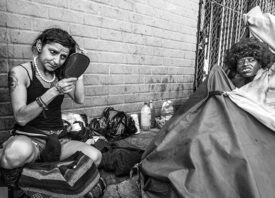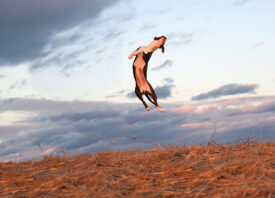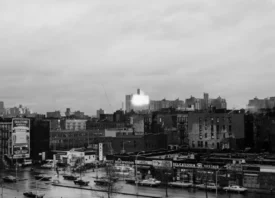Search this site
Skid Row and Beyond: Suzanne Stein Has Never Shied Away from Painful Photos

“Recently, I have learned to accept that many of my images are just too harsh to be shown,” the street photographer Suzanne Stein shared earlier this summer. “There’s so much hardship I see every day. I leave most of it out, and I’ve been told that I should show some range, shoot easier images. Well, I’ve got some stuff coming soon that’s not easy. I’m going to talk about the pictures and what I observed, and I’m going to be honest.”
Stein has been documenting life on the streets of Los Angeles and New York for years, returning to the same corners over and over to visit people and learn more about their stories. Last November, she saw a young man in LA; his wrists and forearms were marked with ligature wounds, suggesting he’d been bound against his will. She went back to find him but never did.
Around Christmas, she lost track of a woman she’d known for three years, Little Bit, before learning that she had experienced a relapse. The two of them ultimately found their way back to each other. Then this summer, Stein learned that a young mom she photographed in NYC, Janelle, had recently passed away from an overdose in her childhood home.
The photographer has spent countless hours on the streets looking for people and asking questions. Sometimes, she’s able to track them down. Sometimes they disappear, and sometimes they die. Perhaps the most she can hope for is a few hours of their time; in exchange, she does her best to ensure they’re not forgotten.
In 2017, Suzanne Stein was chosen as one of the winners of the Feature Shoot Emerging Photography Awards. In the years since then, her work has evolved and expanded. But she’s gone back to the same people again and again, never able to leave them in her rearview mirror. We recently had the chance to catch up with her. You can see more work from Stein here and here and follow her on Instagram at @suzanne_stein.

You won the Emerging Photography Awards in 2017 for your documentation of life on Skid Row. What did this project mean to you back then, and what does it mean to you today? Do you have any updates from any of the people you met at Skid Row?
“Skid Row is a place that is quite literally forged into my core. It’s just part of who I am. Of course, I never lived on those streets, but I’ve spent so much time there. The women I’ve photographed and who have gifted me with their trust are personal icons. I love them deeply and truly. The most striking updates are the most disturbing and disappointing: India’s been missing for over two years, and Christine is so desperately ill with schizophrenia that at last report she was living under a bridge/overpass on her own further out from Skid Row.”
When did you decide to move on from Skid Row, and what did you take with you from your time there?
“I will always return to Skid Row, and I have photographs that I have not put on social media. It’s changed a lot, and become, in many ways, even more deteriorated and incredibly dangerous for me personally because of a specific incident that occurred. I have worked on various projects that mean as much; for example, Ginette’s life as a shut-in in the East Village of Manhattan; Bethany’s life on the street as a transgender woman; Little Bit at midnight on 34th street. I’ve definitely moved on: a bit different but still immersed.”

What was your experience like after winning the awards?
“I think that recognition is a very slow burn for someone with my photographic style. Feature Shoot courageously recognized my work, but because it’s so edgy and raw at times, especially in 2017 when I won, I feel that many editors really did not. I am not one to enter contests generally for many reasons, although I have recently. I am constantly working to my absolute physical limits. I push the bounds of safety and sometimes taste every day. I have no ability to objectively assess my career; I’m just so buried in the acts of making pictures.”

How have you grown as a photographer since winning the awards?
“My proudest moments are nearly always related to the successful execution of a difficult photograph in a tricky situation. I’m really pleased when I go out and strike gold with an image I sweated over or just had fast enough reflexes to grab! Those are my treasures, and I mean that sincerely. As a photographer, I’m much more adept and have learned to use the camera and various focal lengths much more artistically to achieve different modes of making a statement in a picture. I’ve created images I would never have created in 2017.”

Why is it important to you to show the harsh reality of life in our cities, sans sugarcoating, and how do you find the strength and motivation to continue this kind of work?
“I don’t know exactly why I do what I do. I think it’s super, crazy important, especially these days, to tell the truth in photography. There are too many—way too many!— photographic euphemisms out there. People need to see what’s out there and not be presented with easy images that don’t enlighten or pull at the psyche. Social media decides what we see, what it thinks we want, and excludes a great deal of true realism at a time when we’re never sure if we’re being lied to by politicians, the news media, leaving basic facts out, failing to properly fact check or report accurately. Photography for me is absolute and non-negotiable. Realism or die.”

Further reading: A Photographer Sheds Light on Tranq Dope’s Devastating Toll in Philadelphia



